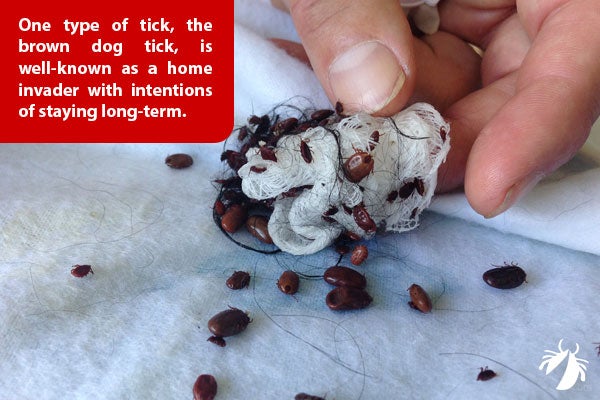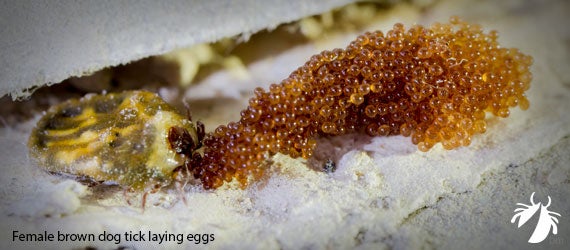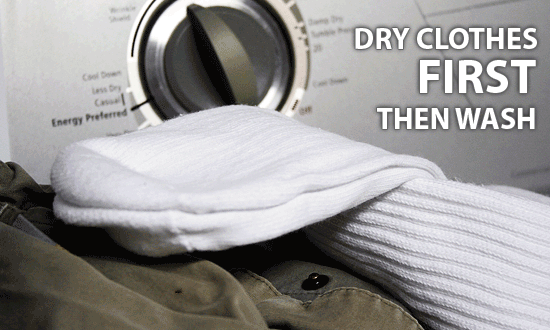Finding ticks in your home or car can be…freaky. But Spring and early Summer, especially, are times of the year that American dog ticks and sometimes other types, too, hitch a ride inside-on pets or clothing-only to show up when you least expect it, on walls, bedding, furniture, floors, tables, you name it! TickSpotters reports of loose and wandering ticks in the home really pick up during May, and almost all of them involve male and female American dog ticks.
One type of tick, the brown dog tick, is well-known as a home invader with intentions of staying long-term. Brown dog ticks typically come in on pets that have visited another infested location, and quickly make themselves at home, reproducing their numbers in swarms by stealing blood whenever they want from unprotected pets. Just a few of these ticks can start a household infestation that literally can take months of persistent effort, and hundreds of dollars (or more), to eradicate. But that’s brown dog ticks, NOT American dog ticks, lone star ticks, or blacklegged (deer) ticks.

To help set your mind at some ease about the potential for a full-blown household tick invasion that leads to a long-term infestation, it’s important to understand the tick life cycle and certain environmental requirements of ticks. All ticks steal blood; immature stage ticks use the blood meal to grow into the next stage-larvae into nymphs, nymphs into adults. And those grossly bloated adult female ticks — they use that huge blood meal to mature eggs — thousands of eggs — that eventually turn into larvae. But maturing eggs, hatching and beginning the tick life cycle anew takes time; in American dog ticks, it can take 3 weeks or longer to lay eggs, and even more time for those ticks to hatch and the larvae to “get hungry”. The question is, can they do all of that in your home.

By spending all of that indoor time outside of an environment with favorable (>50-80% humidity depending on the species), these ticks are just unable to maintain their internal body moisture – they simply “dry out” and die. This IS true, especially for blacklegged ticks, the most desiccation-prone of the bunch but certainly NOT true for brown dog ticks. They can survive even near-desert conditions and, like cockroaches, actually seem to prefer a more “domesticated” environment. American dog ticks and lone star ticks are intermediate in their tolerance of drier conditions; they may survive a few days or even a couple of weeks but not usually long enough to go from one tick stage to the next.
Speaking of “dryer” conditions, one easy way people can decrease the likelihood of bringing these unwanted suckers into their home is by stripping outdoor clothes off right away after coming inside and throwing them in a hot dryer for about 10 minutes. That amount of dry heat is enough to make almost any tick desiccate (any except…brown dog tick).
TickSmart™ Tip#1: DRY CLOTHES FIRST – THEN WASH

But hopefully you’re not going to throw the pet in the dryer. To prevent loose and wandering ticks that come inside on pets from invading your home, you’ll want to use tick control products with quick-kill properties. If the tick gets a deadly dose even before it attaches and starts to feed, and then crawls or falls off the pet, it most likely will die in an hour or two.
And the same goes for your outdoor clothing, too. If it’s treated with permethrin, any loose ticks that might have designs on hitching a ride inside will very quickly fall off and die.
Help keep the ticks outside this Spring and Summer. But if you do find ticks, inside or out, be sure to 1) take a picture, 2) identify the tick, 3) save it, and 4) submit it to TickSpotters. Every submission is helping TickEncounter track tick trends across America – even trends like ticks getting inside of your house.
